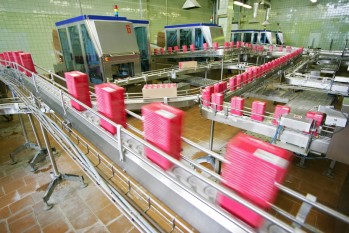Employees must be protected from large amounts of enzymes used in manufacturing. 
10. Post clear signage – Label everything coming into contact with enzymes, and those things that are not, so employees can easily tell the difference. Posting “enzyme” or “non-enzyme” on manufacturing areas, portable equipment, and other critical equipment throughout your facility will help clarify when enzyme handling procedures need to be followed. It can save employees time and you money when extra steps can be eliminated because enzymes are not present.
9. Provide proper PPE (personal protection equipment) for employees – Proper PPE, such as masks and protective gloves, greatly reduce the risk of exposure to enzymes for employees. Make sure clear signage is posted informing employees of the required PPE in the enzyme handling area. It is also a smart idea to have an enzyme handling safety workshop with employees where proper PPE is explained thoroughly.
8. Monitor flows and velocities to confirm dust collector/exhaust systems are fully operational – Dust collection and/or exhaust systems are the key component to containing and safely collecting enzymes during the manufacturing process. However, just having these systems is not enough. Collection systems and exhaust systems must be constantly monitored to make sure they are working correctly and are not clogged.
7. Monitor product storage/transfer/loading/unloading to confirm safe handling. Consider having separate storage areas for products or ingredients containing enzymes. Always ensure that enzymes are transported in sealed containers.
6. Use a portable vacuum (with HEPA filter) or a connection to the house vacuum (piped to enzyme dust collector) for powder spills – Any equipment used to vacuum and contain enzyme powder spills should never be used in any other area of the manufacturing facility. HEPA filters and/or enzyme dust collectors should always be used to effectively capture and remove enzyme powder spills.
5. Treat all waste material as containing enzymes – Anything leaving an enzyme manufacturing area must be assumed to contain enzymes. Transfer scrap/re-blend in closed carts or sealed bags and dispose of properly. Employees handling waste material from enzyme areas should wear proper PPE.
4. Treat all empty containers or cartons as full: Generally the same concept as above: if it was in the enzyme area or contained a product with enzymes than it must be treated as if it still contains enzymes. Containers used to transport enzymes should not be used in other non-enzyme areas of the plant.
3. Eliminate Gross Skin Contact: Ensure that employees that have any long-term or heavy contact with enzyme dust or powder should always wear PPE. Small quantities of dust should be removed by frequently washing exposed areas (example: washing your hands).
2. Eliminate recurring spills or leakage: Spills and leakage in the enzyme area are a constant threat. Machinery should be checked periodically and any problems with product leaking and/or spilling must be solved as quickly as possible.
1. MOST IMPORTANT: DO NOT ALLOW ANY VISIBLE DUST OUTSIDE OF THE CONTAINED SPACE. Dust containing enzymes is the cause of most enzyme exposure incidents. Do not allow liquid spills to dry and evaporate in non-contained spaces. No dust should be visible in the air or on the floor.
ABOUT EPIC: EPIC is an engineering firm specializing in line integration and modular process systems. We provide enzyme handling evaluations for manufacturers. We believe you get a better solution by combining engineered controls with smart and simple operational changes. To learn more about EPIC, contact an engineer today or visit our website.